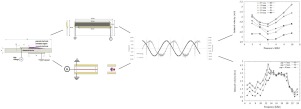Sensors and Actuators A: Physical ( IF 4.6 ) Pub Date : 2020-01-24 , DOI: 10.1016/j.sna.2020.111831 Michael M. Wojewodka , Craig White , Konstantinos Kontis

|
Plasma actuators have attracted interest for use as active flow control devices due to their many benefits; they have no moving parts and are lightweight, can be flush mounted, and require low power. In this study, the performance of plasma actuators are experimentally characterized with dielectric material, dielectric thickness, and operating frequency for surface and channel actuator geometries. The channel height, changing the effective dielectric constant, is also varied. Induced velocities were measured using a pitot tube and PIV, and power consumption levels were recorded. For the surface plasma actuator, PTFE and GRE dielectric materials show similar performance, with Kapton producing the highest induced velocity jet. Higher plasma ionization tends to occur with operating frequencies of 5 and 10 kHz, with a minimum at 7 kHz – possibly related to a change to streamer discharge from corona discharge. Power consumption was also higher at frequencies of 5 and 10 kHz. Thinner dielectric materials outperformed thicker ones for a given high voltage input. GRE, which has the highest dielectric constant of the tested materials, resulted in higher induced velocities than PTFE and Kapton for the same dielectric thickness. For the channel actuator, the smallest air gap corresponding to the lowest permittivity generated the highest peak induced velocity at 12 kHz. Different air gap heights do not seem to affect the induced velocities for frequencies above 14 kHz. A high gradient of velocity reduction with streamwise distance from the exposed electrode of the channel actuators was also observed.
中文翻译:

介电常数和频率对ac-DBD表面和通道等离子体致动器中感应速度的影响
等离子体致动器因其许多优点而引起人们的兴趣,它们被用作主动式流量控制设备。它们没有活动部件,重量轻,可以嵌入式安装,并且需要低功率。在这项研究中,等离子体致动器的性能通过介电材料,介电层厚度以及表面和通道致动器几何形状的工作频率进行了实验表征。改变有效介电常数的沟道高度也变化。使用皮托管和PIV测量感应速度,并记录功耗水平。对于表面等离子体致动器,PTFE和GRE介电材料表现出相似的性能,其中Kapton产生最高的感应速度射流。在5和10 kHz的工作频率下,往往会发生更高的等离子体电离,最低频率为7 kHz –可能与流光放电从电晕放电变化有关。在5 kHz和10 kHz的频率下,功耗也更高。对于给定的高压输入,较薄的介电材料性能优于较厚的介电材料。GRE具有最高的介电常数,在相同的介电层厚度下,其感应速度要比PTFE和Kapton高。对于通道致动器,对应于最低介电常数的最小气隙在12 kHz处产生最高峰值感应速度。对于14 kHz以上的频率,不同的气隙高度似乎不会影响感应速度。还观察到从通道致动器的暴露电极到流向距离的速度降低的高梯度。在5 kHz和10 kHz的频率下,功耗也更高。对于给定的高压输入,较薄的介电材料性能优于较厚的介电材料。GRE具有最高的介电常数,在相同的介电层厚度下,其感应速度要比PTFE和Kapton高。对于通道致动器,对应于最低介电常数的最小气隙在12 kHz处产生最高峰值感应速度。对于14 kHz以上的频率,不同的气隙高度似乎并不影响感应速度。还观察到从通道致动器的暴露电极到流向距离的速度降低的高梯度。在5 kHz和10 kHz的频率下,功耗也更高。对于给定的高压输入,较薄的介电材料性能优于较厚的介电材料。GRE具有最高的介电常数,在相同的介电层厚度下,其感应速度要比PTFE和Kapton高。对于通道致动器,对应于最低介电常数的最小气隙在12 kHz处产生最高峰值感应速度。对于14 kHz以上的频率,不同的气隙高度似乎并不影响感应速度。还观察到从通道致动器的暴露电极到流向距离的速度降低的高梯度。在相同的介电层厚度下,其具有最高的介电常数,从而比PTFE和Kapton具有更高的感应速度。对于通道致动器,对应于最低介电常数的最小气隙在12 kHz处产生最高峰值感应速度。对于14 kHz以上的频率,不同的气隙高度似乎并不影响感应速度。还观察到从通道致动器的暴露电极到流向距离的速度降低的高梯度。在相同的介电层厚度下,其具有最高的介电常数,从而比PTFE和Kapton具有更高的感应速度。对于通道致动器,对应于最低介电常数的最小气隙在12 kHz处产生最高峰值感应速度。对于14 kHz以上的频率,不同的气隙高度似乎并不影响感应速度。还观察到从通道致动器的暴露电极到流向距离的速度降低的高梯度。对于14 kHz以上的频率,不同的气隙高度似乎并不影响感应速度。还观察到从通道致动器的暴露电极到流向距离的速度降低的高梯度。对于14 kHz以上的频率,不同的气隙高度似乎不会影响感应速度。还观察到从通道致动器的暴露电极到流向距离的速度降低的高梯度。


























 京公网安备 11010802027423号
京公网安备 11010802027423号